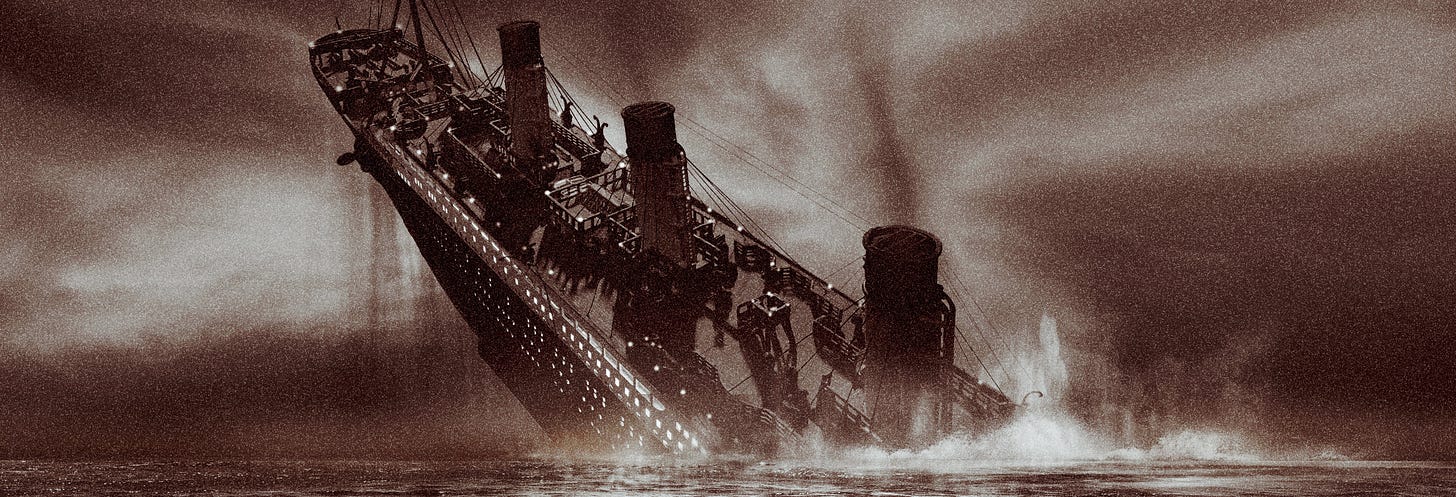When I was perhaps ten or twelve I read Walter Lord’s A Night to Remember, about the sinking of the Titanic. Since then, the following passage has never really left my mind …
It depicts the moment the ship tilted upwards, and the entire contents tumbled from the stern to the bow. Note how all things, trivial and important, valueable and worthless, are jumbled together. After pages and pages of narrative scene, this montage or list occurs as something … marvelous:
“The muffled thuds and tinkle of breaking glass grew louder. A steady roar thundered across the water as everything movable broke loose.
”There has never been a mixture like it—twenty-nine boilers ... the jeweled copy of The Rubáiyát ... 800 cases of shelled walnuts ... 15,000 bottles of ale and stout ... huge anchor chains (each link weighed 175 pounds) ... thirty cases of golf clubs and tennis rackets for A. G. Spalding ... Eleanor Widener’s trousseau ... tons of coal ... Major Peuchen’s tin box ... 30,000 fresh eggs ... dozens of potted palms ... five grand pianos ... a little mantel clock in B-38 ... the massive silver duck press.
”And still it grew—tumbling trellises, ivy pots and wicker chairs in the Café Parisien ... shuffleboard sticks ... the fifty-phone switchboard ... two reciprocating engines and the revolutional low-pressure turbine ... eight dozen tennis balls for R. F. Downey & Co., a cask of china for Tiffany’s, a case of gloves for Marshall Field ... the remarkable ice-making machine on G deck ... Billy Carter’s new French Renault ... the Ryersons’ sixteen trunks, beautifully packed by Victorine.”
We seldom think to use lists in our fiction, but given the power of this passage we can’t ignore such a great device. Especially as a texture that breaks the moment-to-moment drone of Little Voice or Recording Angel. It summarizes—but at the end, once so many of these things have already been established in the reader’s mind.
Compare it to the following passage from The Great Gatsby:
“Once I wrote down on the empty spaces of a time-table the names of those who came to Gatsby’s house that summer. It is an old time-table now, disintegrating at its folds and headed ‘This schedule in effect July 5th, 1922.’ But I can still read the grey names and they will give you a better impression than my generalities of those who accepted Gatsby’s hospitality and paid him the subtle tribute of knowing nothing whatever about him.
“From East Egg, then, came the Chester Beckers and the Leeches and a man named Bunsen whom I knew at Yale and Doctor Webster Civet who was drowned last summer up in Maine. And the Hornbeams and the Willie Voltaires and a whole clan named Blackbuck who always gathered in a corner and flipped up their noses like goats at whosoever came near. And the Ismays and the Chrysties (or rather Hubert Auerbach and Mr. Chrystie’s wife) and Edgar Beaver, whose hair they say turned cotton-white one winter afternoon for no good reason at all.
“Clarence Endive was from East Egg, as I remember. He came only once, in white knickerbockers, and had a fight with a bum named Etty in the garden. From farther out on the Island came the Cheadles and the O. R. P. Schraeders and the Stonewall Jackson Abrams of Georgia and the Fishguards and the Ripley Snells. Snell was there three days before he went to the penitentiary, so drunk out on the gravel drive that Mrs. Ulysses Swett’s automobile ran over his right hand. The Dancies came too and S. B. Whitebait, who was well over sixty, and Maurice A. Flink and the Hammerheads and Beluga the tobacco importer and Beluga’s girls.
“From West Egg came the Poles and the Mulreadys and Cecil Roebuck and Cecil Schoen and Gulick the state senator and Newton Orchid who controlled Films Par Excellence and Eckhaust and Clyde Cohen and Don S. Schwartze (the son) and Arthur McCarty, all connected with the movies in one way or another. And the Catlips and the Bembergs and G. Earl Muldoon, brother to that Muldoon who afterward strangled his wife. Da Fontano the promoter came there, and Ed Legros and James B. (‘Rot-Gut’) Ferret and the DeJongs and Ernest Lilly—they came to gamble and when Ferret wandered into the garden it meant he was cleaned out and Associated Traction would have to fluctuate profitably next day.
Again, note how the list reduces everything to the same status. It flattens the rich and the not-rich in the same way death and memory flatten things. And it shows how proper nouns—names—trivialize any character. Something I hammer on my students about.
Recently I’ve read accounts of other ships passing through the debris field after the Titanic’s sinking, and how many people reported seeing a dead women clutching a shaggy, dead dog. That kind of pathos is the “way in” that would make a stale story fresh. Lists make it fresh. You’ve always got a new angle or a new “texture” of information that will make a story new and horrible in the reader’s mind.
Lists. Use them.








At Study Hall. Slightly burned out. Good night.
First of all, thanks for this awesome post. I’ll add this to my arsenal. I’d always seen groups of four or more, but hadn’t given a lot of thought to extremely long lists that take up pages. I’d noticed them, but didn’t understand how they functioned and how to execute them effectively. Instead I just read them and felt like they worked well for that author, but if I tried them then they wouldn’t work for me and would just seem boring and out of place. Now I get how to implement them successfully.
I just finished reading Slaughterhouse Five. Vonnegut seems to be a master of lists like this, among many other things. I’m wondering if you would consider doing a post (or even multiple posts) on him in the future? His story telling is epic and I know I’ll be reading Slaughterhouse Five for the rest of my life. It blew me away. It seems that every other page I was dog-earing and underlining a technique I wanted to steal.